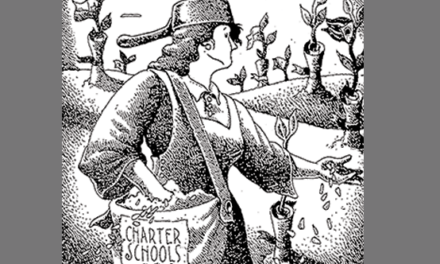Instead of having students debate contentious issues, encourage them to take a problem-solving approach.
In a small town in Appalachia, members of the local Heritage Council — teachers, lawyers, artists, businesspeople, retired coal miners and railway workers, and others — have been discussing how the community can address its declining population and loss of industry. They hope to encourage young people to remain closer to home by developing economic opportunities and protecting the town’s cultural and environmental assets.
Sometimes the council’s deliberations focus on how best to use limited resources, such as relying on volunteers to staff the local museum or partnering with universities to create surveys and business plans. Other decisions involve conflicting priorities, such as whether the riverbank should be restored to a more natural and sustainable condition or should instead include artificial beaches and other accessible spaces, especially for those with limited mobility.
Despite their differing ideas about what to do, members of the council are united in their desire to create a community that has a future: a place their children and grandchildren can be proud of, one where they can live and work if they choose.
This is just one example of the kind of deliberative decision making that people engage in regularly, whether with strangers, co-workers, fellow congregants, or as part of the formal and informal groups that make up civil society. Despite their pervasiveness, such discussions don’t come easily, and schools can play an important role in cultivating the skills students will need to take part in these deliberations, in their lives now and as adults.

The dominant model of classroom deliberation
Civic life depends on people being able to decide together what to do on matters of public policy, and many educators have enthusiastically embraced their responsibility to encourage such deliberation. Walter Parker (2010), Diana Hess (2009), and others have provided powerful rationales for why students need to engage in productive discussion. Numerous professional development programs offer well-designed materials to support classroom deliberation, including the Choices Program, Close-Up Foundation, Constitutional Rights Foundation, and Facing History and Ourselves. Many teachers regularly engage students in discussions related to issues that arise in schools, classrooms, and the broader society.
The dominant model for deliberation tends to center on a particular type of engagement. In this model, students consider opposing viewpoints on an issue, such as reproductive rights, immigration policy, or hate speech. They then take part in structured discussions or debates in which they present reasons and evidence to support a position (sometimes switching positions in the process), so that each side is given a fair hearing. The Structured Academic Controversy (SAC) model (Johnson & Johnson, 1988), which educators in several countries around the world have used (Ang, 2014; Avery, Levy, & Simmons, 2010), is one of the most well-known formats for such deliberation.
This type of deliberation has many advantages. Not only does it require students to consider differing perspectives carefully (including those that may be directly counter to their own), but it also exposes them to the authentic public issues that spark interest and develop their understanding of political life. The focus on dispassionate argumentation, along with careful listening, demonstrates the open-mindedness and trust that are crucial if civic life is to be more than a self-serving quest for advantage. Models such as this provide teachers with a productive and manageable alternative to unstructured discussion of controversial issues, which may lead to little more than passionate shouting.
Drawbacks to the dominant model
Relying exclusively on the dominant model of deliberation limits students’ preparation for public life in two important ways.
Limited modes of discourse
The first drawback is rooted in its requirement that students express themselves through calm and analytic verbal exchanges — the sort of formal reason-giving found in an idealized parliamentary debate. This typically excludes personal narratives, arguments grounded in identity, highly passionate or emotional speech, and nonverbal forms of expression (Gibson, 2020; Knowles & Clark, 2018). Educators may welcome these restrictions because they make discussions more manageable and promote skills that are essential to rational decision making, but restrictions on expression limit students’ ability to engage in public life.
At an obvious and pragmatic level, some students do not excel at formal verbal exchanges and would be better able to express themselves through artistic or creative forms of engagement. More fundamentally, people’s positions on public issues often are grounded in identity and personal experience, and these may inspire great passion. When students are unable to bring these into the deliberation, they may lose interest. Moreover, students who have been traumatized by violence or discrimination should not be told that their emotions and experiences have no place in discussing such issues. Doing so is tantamount to telling them that what matters most to them is irrelevant or even illegitimate.
Limited viewpoints considered
A second drawback to the dominant approach lies in its juxtaposition of contrasting viewpoints. Issues are typically framed as competing alternatives: Should we do x or not (e.g., provide gender-neutral restrooms in schools)? Should we do x or y (e.g., limit gun ownership or strengthen school security)? In this approach, positions are predetermined, and they are chosen to reflect existing policy options that are debated among politicians and the wider public. Although this strategy exposes students to authentic political positions, it can also limit their ability to work together to consider issues thoughtfully and find novel solutions.
Focusing on existing political debates short-circuits reasoning, because students (like adults) often reach conclusions based on their perceptions of what the “correct” position is for someone like them (Green, 2013; Sloman & Fernbach, 2017). Rather than engaging with evidence or competing ideas, they will look for reasons that support their position and aim to score debating points or undermine competing arguments (Clark & Avery, 2018; Crocco et al., 2018).
Students are unlikely, for example, to begin a discussion of whether to defund police departments with open minds. Instead, they will have decided at the outset that they are the kind of people who support police and want to be tough on crime (and therefore oppose defunding) or that they are the kind who are concerned with racial profiling and police brutality (and therefore support defunding). Even when issues are less controversial, adversarial framing sets up the expectation that public policy is a zero-sum game in which one “side” wins and the other loses and that any win must come at someone else’s cost. Although students may be allowed to compromise, the nature of any compromise is framed by the original, competing choices.
Moreover, given that most students’ political identities are still at an early point of development, their responses may be grounded in incomplete ideas about public policy positions. They may conclude that if they identify as members of one political party, they must oppose any measures that would support the well-being of immigrants, or that if they identify with the other party, they must encourage immigration. Some students also choose positions based on narrow interpretations of religious identity. They may believe, for example, that “as a Christian,” they must oppose LGBTQ+ rights or the separation of church and state. The fact that these positions do not necessarily align neatly with political ideologies or religious beliefs is beside the point. Students’ perceptions of how these positions relate to their identities can lock them into positions prematurely and foreclose discussion. Although students may have experiences that would enable them to develop more thoughtful positions (Clay & Rubin, 2020), traditional models of deliberation can make it difficult for students to capitalize on the full range of their knowledge.
An alternative: Collaborative deliberation
We believe that there is an alternative to the dominant format: collaborative deliberation. We define collaborative deliberation as non-adversarial problem solving within a trusting, mutually reciprocal partnership, premised on common interests and involving diverse forms of expression and communication (Barton & Ho, 2022). This is a common process of deliberation outside schools, yet it has received little attention in educational contexts.

Rather than engaging in contentious debates over hot-button issues, members of many communities work together with others who share their goals, values, and concerns. For example, the members of the Heritage Council described at the beginning of this article were not discussing whether to create a future for the community but how best to do so. Similarly, members of an environmental organization may already share an interest in protecting coastal wetlands, and their focus is not on whether to devote resources to protecting them but on how best to do so. (See Table 1 for a summary of the differences between the two types of deliberation.)
In settings like these, people work together to clarify issues (Why are people leaving the community? What are the boundaries of the wetlands?); weigh alternatives (Which strategies will be most effective? Which organizations or individuals should we work with?); and justify possible actions (Creating hiking trails provides recreational opportunities and bolsters the economy. Using volunteers to plant and restore native vegetation not only protects the coast from erosion but also educates the public).
These discussions may be just as difficult as adversarial ones. Members of the group will still disagree, and they may be strongly committed to their own way of seeing things. In some cases, the discussion will be more difficult, because those involved usually hope to maintain their relationships (with friends, neighbors, and co-workers) amid disagreement — something that may be less of a priority in a more polarized environment. Nonetheless, the nature of such disagreements will differ because they are set up not as conflicts between opposed goals but as attempts to work together on a shared problem.
The benefits of collaborative deliberation
As with adversarial deliberation, the purpose of collaborative deliberation is discussion “with an eye towards decision-making” (Parker, 2003, p. 80). These decisions focus on means rather than ends: how to staff the museum or how to restore wetlands to prevent flooding. They therefore provide a meaningful context within which people can work together on issues that already matter to them, rather than trying to find common ground across frequently unbridgeable divides.
Collaborative deliberation also encourages a greater range of expressive forms. Discussions among neighbors, co-workers, or members of community groups do not always rely on formal modes of communication, governed by rules and norms that emphasize dispassionate, formal, and analytical ways of speaking. In many settings, people are more accepting of personal storytelling, highly impassioned pleas, or other modes of expression.
This communicative diversity can bring more voices, including those that are sometimes marginalized, into public decision-making processes. The willingness of participants to embrace different, often culturally based, verbal and nonverbal ways of arguing, agreeing, and explaining can promote greater inclusiveness; reduce “deliberative inequalities” (Hendriks, 2006, p. 496); and potentially mitigate unequal power relations within a group.
Both the expressive inclusiveness and emphasis on mutual goals that are part of collaborative deliberation reflect real world styles of decision making. Outside artificial exercises, such as deliberative polling (Fishkin, Luskin, & Jowell, 2000) or citizens’ assemblies (Lacelle-Webster & Warren, 2021), people do not often come together for thoughtful discussion with those whose views are diametrically opposed to their own. Perhaps they should do so, but such discussions are rare and have become even less frequent with increasing political and social polarization.
In any setting or community, though, people still must work with others. And most often people who are working together share similar goals. Rather than only preparing students for formal discussions with people they disagree with, therefore, we also need to equip them to engage in these more realistic settings.
Organizing for collaborative deliberation
If students are to be prepared for collaborative deliberation, what should schools be doing differently? We recommend that teachers follow three steps when organizing for deliberation.
Frame questions in open, non-adversarial forms
As a first step, teachers need to consider how to frame issues for deliberation. Framing, because it helps define the problem, delineates the range of appropriate solutions and determines the types of actions that should be taken (Benford & Snow, 2000). Joint, non-adversarial problem solving requires questions that invite open-ended consideration of a common concern rather than support for, or opposition to, a given policy.
For example, rather than positioning an issue such as child care in an adversarial manner (Should the state provide universal child care?), teachers can reframe it in a more open, less polarizing way (How can working families have greater access to child care?). Similarly, rather than an either-or question related to free speech (Should hate speech be permitted?), teachers can reframe the issue as protecting the safety of vulnerable or targeted populations (How can vulnerable groups be protected against verbal attacks?).
At a more advanced level, teachers also can help students consider how the framings they encounter in media, politics, and other forms of public discourse may shut out discussion and consensus. Students could then suggest how they might revise public questions to focus on shared values such as fairness or safety (Hauver, 2019). This allows students to become more thoughtful about the discourses around them.
Help students identify shared interests and perspectives
Second, teachers need to consider different ways of organizing students for deliberation. Certainly, the for-or-against format used in adversarial deliberations is inappropriate for collaborative deliberation. Attempting to identify points of disagreement within a seemingly homogenous classroom in order to create conditions for debate (Hess, 2009) would also be counterproductive. Instead, teachers may want to consider how to help students articulate shared goals, values, and priorities as a basis for collaborative deliberation.
Students naturally gravitate toward those with whom they feel comfortable, but frequently this is based solely on similarities in background. Teachers can help students find more meaningful common ground by, for example, having them explore shared connections and concerns. In classrooms, as in the wider society, shared interests and trusting relationships are not automatic; children and adults often must forge these out of diverse backgrounds and perspectives. Helping students discover common goals and build trust, then, becomes an important means of preparing them for collaborative deliberation.
Teachers need to establish norms that accept different forms of expression, make space for expressions of emotion and passion, and allow for a range of discourse, including arguments supported by personal testimony.
This could lead to multiple groups, within the same classroom, pursuing the same broad question alongside other like-minded students. For example, if a class is considering a topic such as access to child care, some students may be more inclined to explore market-based strategies, such as deregulation or tax incentives for providers. Others may want to examine state subsidies or payments to parents; and still others may be more interested in expansion of state-run facilities, or even the broader issue of how to decrease child-care needs through longer parental leave or more flexible working conditions.
The result of these small-group deliberations will be a diversity of potential solutions, and some may well conflict with or contradict each other. There are, after all, competing goals and social visions in any society. These conflicts will not disappear, no matter how skilled we are at collaboration. Such conflicts, though, will be the outcome of deliberative attempts to solve a problem, not the starting point for discussion. As a result, the positions should be more nuanced and complex, as well as better grounded in evidence (both personal experience and other reasons), than the kinds of argumentation that arise from a choice between preexisting positions.
Encourage and teach diverse forms of expression
Third, when considering the form of collaborative deliberation, teachers need to pay attention to establishing inclusive norms of communication within the classroom. Real-world deliberations can be relatively messy, fluid, unstructured, and accepting of different communicative styles (Hendriks, 2006; Young, 2000). Teachers need to establish norms that accept different forms of expression, make space for expressions of emotion and passion, and allow for a range of discourse, including arguments supported by personal testimony.
Encouraging diverse forms of communication also requires that teachers help students understand how to deploy these methods effectively. Emotional appeals and personal stories can be powerful and compelling, but they also can be distracting, ineffective, or ill-suited to a given moment. Teachers must help students gain insight into when to use various forms of communication, how to do so effectively, and what purposes different forms of expression can serve. Students also need to learn how to attend to, make sense of, and respond to these varied formats (Andolina & Conklin, 2021).
Preparation for the real world
The high level of polarization in many societies has led to discord, distrust, and even violence among those with competing viewpoints. Most educators decry this situation, and many hope that they can guide young people toward more productive ways of discussing public issues. These attempts, however, rest on the assumption that deliberation inevitably involves competition between opposed ideas. The presumed solution to polarization, then, is to help students better understand the “other” side and engage with them in more civil and analytic ways. Unfortunately, the structures for doing this in classrooms can lead to dead-end discussions that fail to live up to the potential of deliberation.
A collaborative model of deliberation recognizes that not all policy discussions involve competing values or a zero-sum quest for advantage and that not all discussions must be calm or formal. Many of the most common forms of deliberation involve joint problem solving with like-minded individuals. These discussions often allow for a wide range of expressive styles. Such discussions are no easier than adversarial ones, but they take a different form and have their own demands and challenges. If we want students to work with others in the creation of a better world, we must prepare them for collaboration as well as conflict.
Note: The authors would like to thank Hilary Conklin, Rob Kunzman, and Shaunna Scott for their valuable input on this article.
References
Andolina, M.W. & Conklin, H.G. (2021). Cultivating empathic listening in democratic education. Theory & Research in Social Education, 49 (3), 390-417.
Ang, L.H. (2014). Structured academic controversy for upper secondary social studies. HSSE Online, 3 (2), 35-39.
Avery, P.G., Levy, S.A., & Simmons, A.M.M. (2010). The expanding Deliberating in a Democracy (DID) project: Evaluation report: Year 3. Project narrative. Deliberating in a Democracy.
Barton, K.C. & Ho, L.C. (2022). Curriculum for justice and harmony: Deliberation, knowledge, and action in social and civic education. Routledge.
Benford, R.D. & Snow, D.A. (2000). Framing processes and social movements: An overview and assessment. Annual Review Sociology, 26, 611-639.
Clark, C. & Avery, P. (2016). The psychology of controversial issues discussions: Challenges and opportunities in a polarized, post-9/11 world. In W. Journell (Ed.), Reassessing the social studies curriculum in a polarized world (pp. 109–121). Rowman and Littlefield.
Clay, K.L. & Rubin, B.C. (2020). “I look deep into this stuff because it’s a part of me”: Toward a critically relevant civics education. Theory & Research in Social Education, 48 (2), 161-181.
Crocco, M., Halvorsen, A., Jacobsen, R., & Segall, A. (2018). Less arguing, more listening: Improving civility in classrooms. Phi Delta Kappan, 99 (5), 67-71.
Fishkin, J.S., Luskin, R.C., & Jowell, R. (2000). Deliberative polling and public consultation. Parliamentary Affairs, 53 (4), 657-666.
Gibson, M. (2020). From deliberation to counter-narration: Toward a critical pedagogy for democratic citizenship. Theory & Research in Social Education, 48 (3), 431-454.
Green, J. (2013). Moral tribes: Emotion, reason, and the gap between us and them. Penguin Books.
Hauver, J. (2019). Young children’s civic mindedness: Democratic living and learning in an unequal world. Routledge.
Hendriks, C.M. (2006). Integrated deliberation: Reconciling civil society’s dual role in deliberative democracy. Political Studies, 54 (3), 486-508.
Hess, D.E. (2009). Controversy in the classroom: The democratic power of discussion. Routledge.
Johnson, D.W. & Johnson, R.T. (1988). Critical thinking through structured controversy. Educational Leadership, 45 (8), 58-64.
Knowles, R.T. & Clark, C.H. (2018). How common is the common good? Moving beyond idealistic notions of deliberative democracy in education. Teaching and Teacher Education, 71, 12-23.
Lacelle-Webster, A. & Warren, M. (2021). Citizens’ assemblies and democracy. In W.R. Thompson (Ed.), Oxford research encyclopedia of politics. Oxford University Press.
Parker W.C. (2010). Listening to strangers: Classroom discussion in democratic education. Teachers College Record, 112 (11), 2815-2832.
Sloman, S. & Fernbach, P. (2017). The knowledge illusion: Why we never think alone. Riverhead Books.
Young, I.M. (2000). Inclusion and democracy. Oxford University Press.
This article appears in the February 2023 issue of Kappan, Vol. 104, No. 5, pp. 44-49.
ABOUT THE AUTHORS

Keith C. Barton
Keith C. Barton is a professor in the Department of Curriculum and Instruction at Indiana University, Bloomington.

Li-Ching Ho
Li-Ching Ho is a professor in the Department of Curriculum and Instruction at the University of Wisconsin-Madison.











